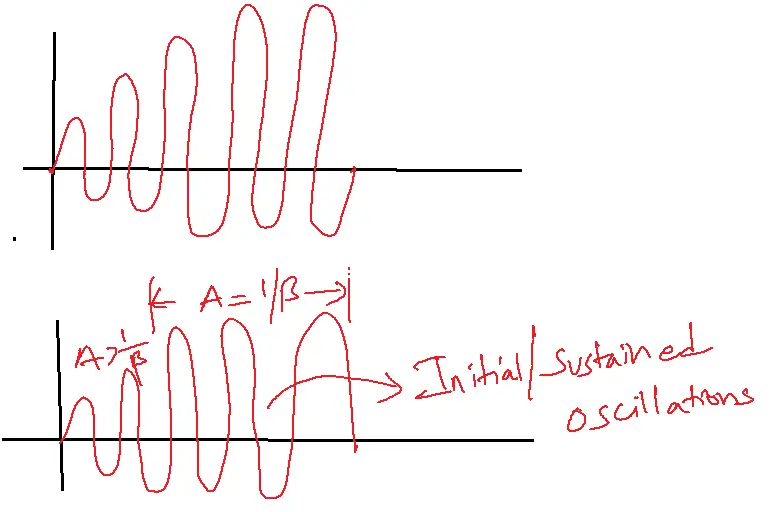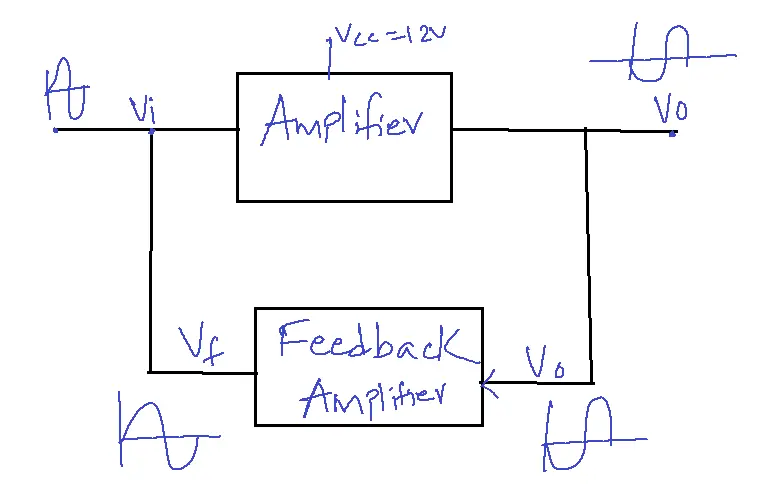Based on characteristics, applications, and design there are a lot of types of oscillator
Oscillator
An oscillator is a device or system that produces a repetitive signal or motion, oscillating between two or more states, frequencies, or amplitudes.
It is an electronic circuit that provides AC output without applying an AC input signal.
To produce AC output the circuit is supplied with DC energy.
Positive feedback is the type of feedback we use in the oscillator circuits.
Input and feedback signals are in phase then the type of feedback is positive feedback.
Af = A/ 1- Aβ
Loop gain Aβ = 1
Af = A/0 =infinity, But we know that Af = Vo/Vs = infinity. An output signal can only be present when there is no input gain, i.e., Vs = 0. In other words, the absence of input gain is a necessary condition for the existence of an output signal. This is the concept of oscillators.
Table of Contents
These are essential components in various fields, including:
1. Electronics: Generating clock signals, carrier waves, and test signals.
2. Mechanical Systems: Creating repetitive motion in engines, gearboxes, and mechanical devices.
3. Control Systems: Industrial process control involving regulating temperature, pressure, and flow rate.
4. Communication Systems: Modulating signals for transmission and reception.
5. Medical Devices: Monitoring vital signs, like heart rate and breathing.
6. Astronomy: Measuring celestial bodies’ positions and movements.
Types of oscillator
1. According to the waveform generated, types of oscillators are classified as:
i. Sinusoidal oscillators [generate sine signals]
ii. Relaxation oscillators [generate Non-sine signals]

2. According to the fundamental mechanism, types of oscillators are classified as:
i. Negative resistance oscillators
ii. Feedback oscillators
3. According to the frequency generated, types of oscillators are classified as:
i. Audio frequency oscillators [up to 20 KHz]
ii. Radiofrequency oscillators [20 KHz to 30 MHz]
iii. Very high-frequency oscillators [30 MHz to 300 MHz]
iv. Ultra high frequency oscillators [300 MHz to 3 GHz]
v. Microwave frequency oscillators [above 3 GHz]
4. According to the type of feedback elements used, types of oscillators are classified as:
i. L-C oscillator
ii. R-C oscillator
Here are some common types of oscillator:
1. Harmonic Oscillator
– Produces a sinusoidal output
– Examples: LC oscillators, crystal oscillators
-It is one of the types of oscillator
2. Relaxation Oscillator
– Generates a non-sinusoidal output (e.g., square, triangular)
– Examples: RC oscillators, astable multivibrator
-It is one of the types of oscillator
3. LC Oscillator
– Uses inductive (L) and capacitive (C) components
– Examples: Colpitts, Hartley, Clapp oscillators
-It is one of the types of oscillator
4. Crystal Oscillator
– Employs a crystal’s piezoelectric properties
– High-frequency stability and accuracy
-It is one of the types of oscillator
5. Numerical Oscillator
– Simulates oscillations using numerical methods
– Used in digital signal processing and simulations
-It is one of the types of oscillator
6. RC Oscillator
– Uses resistive (R) and capacitive (C) components
– Examples: Phase-shift, Wien-bridge oscillators
7. Astable Multivibrator
– Produces a square-wave output
– Used in digital circuits and timing applications
8. Monostable Multivibrator
– Produces a single output pulse
– Used in timing and pulse-generation applications
9. Bistable Multivibrator
– Has two stable states
– Used in flip-flop circuits and memory elements
10. Voltage-Controlled Oscillator (VCO)
– Frequency controlled by input voltage
– Used in phase-locked loops and frequency synthesis
Mechanism to start oscillations
The responsibility of initial oscillations is noise present in the transistor. Noise, an undesirable electrical signal, is inherently present in electrical devices, with amplitudes ranging from nanovolts to microvolts. Because of amplifying action and voltage the output signal goes on increases and becomes saturated at one point.

Barchasan Criteria
To get a sustained oscillator, the circuit has to satisfy two conditions:
A= Vo/Vi
β= Vf/Vo
Vf = β A Vi
Sustained oscillations can be achieved when the loop gain, Aβ, equals 1, resulting in Vf = Vi.

This criteria states that
1. The loop gain A β = 1
2. The total phase shift around the closed loop circuit will be 360 degrees or zero degrees.
Advantages of Oscillators
1. Stable Frequency Generation: These devices produce a stable frequency output, essential for various applications.
2. High Accuracy: These devices offer high accuracy and precision in frequency generation.
3. Low Noise: These devices generate low-noise signals for sensitive applications.
4. Flexibility: These devices can be designed to operate over a wide range of frequencies.
5. Compact Design: These devices can be implemented in a complex design, suitable for integrated circuits.
6. Low Power Consumption: These devices can consume low power, making them suitable for battery-powered devices.
7. High Reliability: These devices can offer high reliability and stability, essential for critical applications.
Disadvantages of Oscillators
1. Sensitivity to Temperature: These devices can be sensitive to temperature changes, affecting frequency stability.
2. Noise Susceptibility: These devices can be predictable to noise, affecting signal quality.
3. Limited Tuning Range: These devices may have a limited tuning range, restricting frequency adjustability.
4. Complex Design: These devices can have a complex design, requiring expertise in implementation.
5. Dependence on Components: These rely on high-quality components, affecting overall performance.
6. Potential for Instability: These devices can become unstable if incorrectly designed or implemented.
7. Maintenance Challenges: These devices can be challenging to maintain and repair, especially in complex systems.
Applications
Oscillators have a wide range of applications in various fields, including:
1. Electronics: Clock signals, signal processing, and frequency synthesis.
2. Communication Systems: Carrier wave generation, modulation, and demodulation.
3. Computing: Clocking, timing, and synchronization.
4. Medical Devices: Heart rate monitoring, ECG, and medical images.
5. Aerospace Engineering: Navigation, timing, and control systems.
6. Industrial Automation: Motor control, timing, and synchronization.
7. Audio Equipment: Tone generation, filtering, and sound processing.
8. Measurement Instruments: Frequency measurement, calibration, and testing.
9. Radar Technology: Signal generation, modulation, and processing.
10. Scientific Research: Particle accelerators, spectroscopy, and experimental physics.
11. Gaming Consoles: Clocking, timing, and audio processing.
12. Mobile Devices: Clocking, timing, and audio processing.
13. Automotive Systems: Engine control, timing, and fuel injection.
14. Power Generation: Synchronization, timing, and control.
15. Navigation Systems: GPS, timing, and synchronization.
FAQs
1. What is an oscillator?
- The oscillator generates continuous, repetitive electronic signals.
- It constitutes an integral part of electronic devices, furnishing essential timing and reference signals.
2. What are the main types of oscillators?
- Oscillators can be broadly classified into two main categories:
- Sinusoidal oscillators: Generate uninterrupted sinusoidal waveforms, fundamental for communication and signal processing applications. Common types include:
- LC oscillators (Hartley, Colpitts, Clapp)
- RC oscillators (Wien bridge, phase-shift)
- Crystal oscillators
- Relaxation oscillators: Create non-sinusoidal waveforms for timing and control circuits, such as square, triangle, or sawtooth waves.
- Astable multivibrators
- 555 timer-based oscillators
- Sinusoidal oscillators: Generate uninterrupted sinusoidal waveforms, fundamental for communication and signal processing applications. Common types include:
3. What factors influence the choice of oscillator type?
- The choice depends on several factors:
- Frequency range: Different oscillators are suitable for different frequency ranges.
- Waveform stability: Some applications require highly stable waveforms.
- Cost and complexity: Simpler oscillators are generally less expensive.
- Power consumption: Battery-powered devices may need low-power oscillators.
4. What are the applications of oscillators in electronics?
- Oscillators are used in a wide array of electronic devices and systems:
- Communication systems: Generate carrier waves for modulation and demodulation.
- Clock circuits: Provide timing signals for digital systems.
- Sensor interfaces: Convert analog sensor signals into digital form.
- Power supplies: Regulate voltage and frequency switching power supplies.
- Audio and video equipment: Generate audio and video signals.
5. What are some common challenges in designing oscillators?
- Designing oscillators can be tricky due to
- Stability issues: Ensuring stable frequency and amplitude over time and temperature variations.
- Phase noise: Minimizing unwanted phase fluctuations in the output signal.
- Start-up issues: Ensuring reliable oscillation start-up.
- Component tolerances: Accounting for variations in component values that can affect frequency.
